Matador Network's Blog, page 29
July 3, 2025
Best Airbnbs in Atlanta, Georgia

Atlanta has thriving art, music, and food scenes that make it an ideal place for a weekend staycation. A sprawling metro surrounded by hilly forest, Atlanta’s delightfully green cityscape surprises many first-time visitors. This makes renting an Airbnb over a hotel a really nice option, especially for those who like to be able to enjoy the amenities of the city but prefer a peaceful home to return to. All of the options listed below are perfect for a couple of solo travelers. From tiny houses to a renovated airstream, these are the top Airbnb Atlanta rentals to take advantage of the South’s most vibrant city.
Traveling in the South? Check out Matador’s accommodations guides: Gorgeous Tennessee Airbnbs across the state for your next southern roadtrip The best Airbnbs in Nashville for a bachelorette getaway The 11 best Nashville Airbnbs by neighborhood 15 Gorgeous Airbnb Cabins in the Smoky Mountains for a Cozy Getaway Escape To These Dreamy Gatlinburg Airbnbs High in the Smokies These Airbnbs in Savannah, Georgia, Put You Close To Downtown, the River, and the Beach 9 Perfect Atlanta Airbnbs To Experience the Best of the City The best Atlanta airport hotels Book these gorgeous Birmingham Airbnbs near the heart of the city Why it’s more important to visit Alabama now than ever Gulf Shores Airbnb rentals near the beach and the best of the city
We hope you love the Airbnb Atlanta stays we recommend! Just so you know, Matador may collect a small commission from the links on this page if you decide to book a stay. Listed prices are accurate as of the time of publication.
Virginia Highlands home with pool Photo: Airbnb
Photo: Airbnb Photo: Airbnb
Photo: Airbnb Photo: Airbnb
Photo: Airbnb Photo: Airbnb
Photo: AirbnbSee more photos
Virginia Highlands is Atlanta’s best neighborhood for both chic accommodation and accessibility to the best of the city. This opulent home has a large patio overlooking the skyline, with a pool that catches the sunset every night. Inside, there’s space for your entire crew in a well-trimmed setting that makes this pad the type of place that makes your stay as memorable for the home as for the things you do while here. In fact you may not even want to leave the house — and we don’t blame you.
Six guests, three bedrooms
Price: $645 per night
 Photo: Airbnb
Photo: Airbnb Photo: Airbnb
Photo: Airbnb Photo: Airbnb
Photo: Airbnb Photo: Airbnb
Photo: AirbnbSee more photos
There are two types of people in this world. Those who have always wanted to stay in a castle, and liars. This Atlanta castle Airbnb, located in the historic Fourth Ward, is epic on many fronts, not least because you can fulfill that dream without having to fly to Ireland. The rooftop patio offers views out over the city. The kitchen is stocked for a meal of royal proportions. And you’re within walking distance of Ponce City Market and the Beltline. Historic Atlanta doesn’t get better than this.
Eight guests, three bedrooms
Price: $586 per night
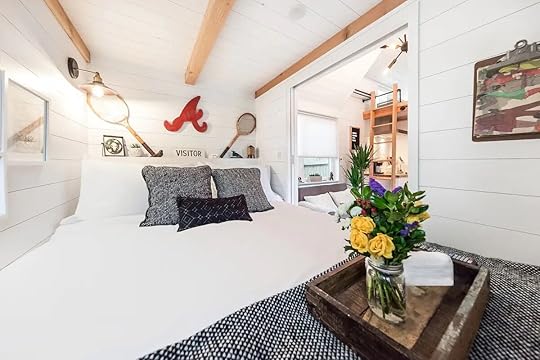 Photo: Airbnb
Photo: Airbnb Photo: Airbnb
Photo: Airbnb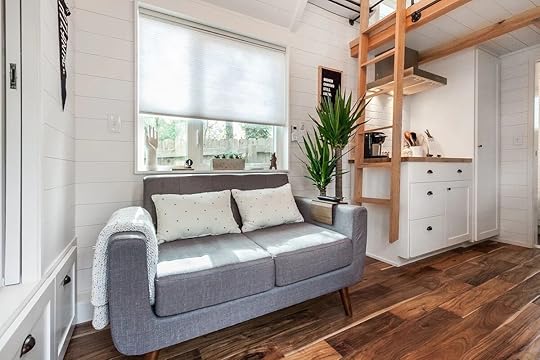 Photo: Airbnb
Photo: Airbnb Photo: Airbnb
Photo: AirbnbSee more photos
This modern chic tiny house is among the top Airbnb Atlanta properties for small groups. It has two queen-sized beds, one on the ground floor and another in a loft space. It’s a charming place with a large farm-style dining area, an outdoor fire pit, and a ping pong table. Guests rave about the host’s hospitality and the rental’s location. It’s a short walk from the vibrant hub of Ponce City Market, one of the world’s best food halls at Krog Street Market, and the Atlanta Beltline.
Four guests, two bedrooms
Price: $103 per night
 Photo: Airbnb
Photo: Airbnb Photo: Airbnb
Photo: Airbnb Photo: Airbnb
Photo: Airbnb Photo: Airbnb
Photo: AirbnbSee more photos
Named one of Airbnb’s most wish-listed properties, this rental might look like it’s in a secluded forest, but it’s actually in the heart of Atlanta. The treehouse is made up of three separate structures, a sitting room, a double bedroom, and a hammock deck. The bathroom is located on the ground level in the main house, to which guests have private access to. One of the main draws of this rental is its natural surroundings and its open-planned layout. It also has a double bed on wheels, so if the weather permits, guests can choose to sleep outside on the deck.
Two guests, one bedroom
Price: $389 per night
 Photo: Airbnb
Photo: Airbnb Photo: Airbnb
Photo: Airbnb Photo: Airbnb
Photo: Airbnb Photo: Airbnb
Photo: AirbnbSee more photos
Secluded on the outskirts of Atlanta, this carriage house is a great option for those who want to be close enough to the city to do a little shopping and sightseeing but prefer a more low-key vacation. The interior is modern and stylish, with a very well decked-out kitchen and comfortable living room. Outside there is a smart patio area with seating, a grill, and an open fire. Some frequent guests have made it a regular place to stay as it’s a super base for exploring the city.
Two guests, one bedroom
Price: $99 per night
 Photo: Airbnb
Photo: Airbnb Photo: Airbnb
Photo: Airbnb Photo: Airbnb
Photo: Airbnb Photo: Airbnb
Photo: Airbnb Photo: Airbnb
Photo: AirbnbSee more photos
This unique and charming cottage is located on a family-run urban farm that is home to a herd of alpacas and llamas. This is another well-appointed property that would be great for those who have a vehicle and want to be outside of the city limits. The cottage is surrounded by dogwoods and pines, expansive perennial gardens, and an organic vegetable garden. The interior is stunning, with white timber-clad walls and brightly colored furnishings and textiles. There are many things to love about this property, but its porch (with a daybed) looks particularly welcoming as an ideal spot to relax with a book and hang out with some of the resident farm animals.
Four guests, one bedroom
Price: $339 per night
 Photo: Airbnb
Photo: Airbnb Photo: Airbnb
Photo: Airbnb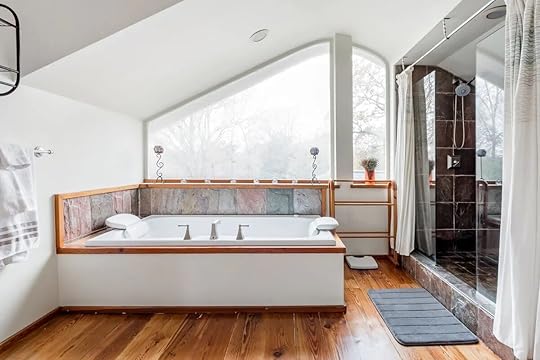 Photo: Airbnb
Photo: Airbnb Photo: Airbnb
Photo: AirbnbSee more photos
This studio is located on the second floor of a bungalow and is walking distance from the leafy Candler Park. The one-bed is spacious with 21-foot ceilings and a lovely porch with unobstructed city views. The decor is a pleasant blend of modern with antique accents. The property comes with a kitchenette — meaning no full-service cooking facilities — but for those who enjoy eating out, the neighborhood of Little Five Points is close by and has a range of excellent restaurants. Highlights include local favorite The Vortex Bar and Grill, The Porter Beer Bar, and natural food joint Arden’s Garden.
Three guests, one bedroom
Price: $99 per night
 Photo: Airbnb
Photo: Airbnb Photo: Airbnb
Photo: Airbnb Photo: Airbnb
Photo: Airbnb Photo: Airbnb
Photo: AirbnbSee more photos
Located just a block from the main entrance to Piedmont Park, this Midtown Atlanta apartment offers a sleek, contemporary space with thoughtful design and a prime location. The interior is clean and modern, with a streamlined layout that includes a private bedroom with an attached bath, plus a stylish living area with a queen sofa bed and NYC loft-inspired touches. The kitchen is outfitted with stainless steel appliances and granite countertops, and the entire space is flooded with natural light.
Amenities include fast Wi-Fi, Roku-equipped smart TVs, a Keurig machine, and a smart lock for convenient, keyless entry. While the building doesn’t have an elevator, those willing to take the stairs will be rewarded with direct access to Atlanta’s green heart, just steps from the Botanical Garden, Whole Foods, and some of the city’s best restaurants and nightlife. Public transportation is nearby, and scooters make it easy to zip around town without a car.
Two guests, one bedroom
Price: $225 per night
 Photo: Airbnb
Photo: Airbnb Photo: Airbnb
Photo: Airbnb Photo: Airbnb
Photo: Airbnb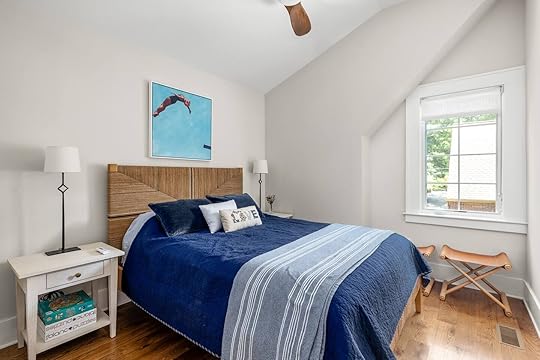 Photo: Airbnb
Photo: AirbnbSee more photos
In a quiet corner of Buckhead, this two-level guesthouse offers a luxurious urban escape complete with a saltwater pool and modern design details throughout. Recently constructed and thoughtfully outfitted, the space features a fully updated kitchen, two full bathrooms, a private garage, and a sleek living area with a West Elm sleeper sectional. The primary bedroom includes a queen-size bed with a luxury memory foam mattress and Tempur-Pedic pillows, while the poolside wet bar and fiber gigabit internet add convenience for both leisure and remote work. Guests also have access to a NEMA 14-50 EV charger—just bring your own cables.
Though located in one of Atlanta’s most sought-after neighborhoods, the guesthouse maintains a sense of privacy, with exclusive use of the backyard and pool area during your stay. You’re just a short walk or quick drive from the city’s premier shopping and dining, including Phipps Plaza, Lenox Mall, Buckhead Village, and Whole Foods. Pets are welcome (with a fee), and guests are asked to respect local noise ordinances and pool hours. Heated pool access is available for an additional charge, and while the main house sits empty, the guesthouse remains fully self-contained—designed for comfort, calm, and a little sun-soaked indulgence in the heart of the city.
Four guests, one bedroom
Price: $250 per night
 Photo: Airbnb
Photo: Airbnb Photo: Airbnb
Photo: Airbnb Photo: Airbnb
Photo: Airbnb Photo: Airbnb
Photo: AirbnbSee more photos
High on a hill with panoramic views of Atlanta’s skyline, this luxury home offers a striking blend of tranquility and walkable urban convenience. From its expansive, fully furnished front porch—complete with a swinging daybed and city-facing lounge—guests can sip morning coffee while watching the sun rise over the skyline, or unwind in the evening with a glass of wine and the city lights twinkling below. The home sits in one of Atlanta’s most desirable neighborhoods, just a short stroll from Piedmont Park, the BeltLine, local theaters, museums, and a host of top-tier restaurants and cafés.
Inside, the 2,600-square-foot residence is outfitted for both relaxation and entertaining. Hardwood floors, curated artwork, and warm, contemporary furnishings create a space that feels both high-end and homey. The layout includes two bedrooms and a convertible office/den that comfortably sleeps six, plus a grand master suite with over 900 square feet of private living space, a spa-like bath with a bubble massage tub, and its own entertainment area. Outdoors, the amenities continue with a resort-style pool, spa, fire pit, and a fully equipped alfresco kitchen and dining area—ideal for laid-back afternoons under the Georgia sun.
Five guests, three bedrooms
Price: $900 per night
 Photo: Airbnb
Photo: Airbnb Photo: Airbnb
Photo: Airbnb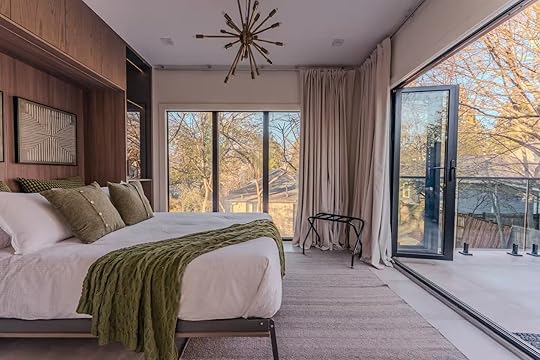 Photo: Airbnb
Photo: Airbnb Photo: Airbnb
Photo: AirbnbSee more photos
In a quiet backyard in one of Atlanta’s most sought-after neighborhoods, this thoughtfully designed tiny house offers a chance to experience small-space living without sacrificing comfort or style. You’ll enjoy easy access to attractions like Ponce City Market, Krog Street Market, and the Atlanta BeltLine, the home is ideally situated for travelers looking to explore the city’s best restaurants, boutiques, and green spaces. Despite its petite footprint, the house delivers on convenience, with easy access to MARTA, major highways, and the airport.
Inside, the space is a study in cozy, modern farmhouse design—light-filled, wrapped in crisp white shiplap, and outfitted with two queen beds (one on the main level and one in the loft). A full kitchen and bathroom, high-speed Wi-Fi, and a washer/dryer make longer stays a breeze. Outside, a private fenced yard includes a fire pit, ping pong table, and plenty of room to unwind. Guests have their own entrance and designated parking, ensuring both privacy and ease. It’s a clever blend of form and function—tiny living done right in the heart of Atlanta. 
Four guests, two bedrooms
Price: $150 per night
July 2, 2025
An Arctic Packing List: What to Buy, Rent, and Leave at Home

Packing for a summer trip to the Arctic Circle is more complicated than it seems. You’ll need to balance comfort with adaptability, variability, and sustainability — plus, it all needs to fit in your suitcase, bulky jackets and all. Most people, myself included, visit the Arctic Circle in the middle of summer. But even in summer, weather can be famously fickle, with days quickly moving from sunshine to bone-chilling wind and fog. Temperatures can be into the 40s Fahrenheit (or 50s, in my case), but feel much colder when you’re on the water in an inflatable Zodiac or getting blasted with winds atop a snowy mountaintop. Conversely, you’re bound to get sweaty and uncomfortable if you wear too many layers when hiking through deep snow.
I recently spent eight days in the Arctic Circle, circumnavigating Svalbard, the northernmost island of Norway, on a Lindblad Expeditions small-ship expedition wildlife cruise. Here’s what I had on my Arctic packing list, including what I bought, what I borrowed or rented, and what I didn’t need at all.
If you don’t want to buy everything new, I recommend checking local used gear and thrift stores first. Several of the items I wore on board the most, including a fleece pullover, a few long-sleeve base layers, and a pair of joggers, came from my local thrift store. You can also rent camera gear from stores like BorrowLenses, and sometimes, even rent clothing through your trip operator. And if you’re an REI member, you can find deals on excellent brands like Mountain Hardwear and Helly Hansen from REI Used Gear.
We hope you love the gear we recommend! Just so you know, Matador may collect a small commission from the links on this page if you decide to make a purchase — it’s one of the ways we keep our articles always free to read. Listed prices are accurate as of the time of publication.
Arctic Packing List: Things You Will Definitely NeedA Multi-Country Plug Adapter
Photo: Suzie Dundas
I stayed in Svalbard on a ship that mostly caters to American travelers, so it actually had plenty of plugs with US ports. But I appreciated having an international plug in airports and in my hotel before and after the trip. I highly recommend this plug converter from Matador (no relation), as it has movable ports to work in every country, so you don’t need to carry attachments with it. It’s got three USB ports and two USB-C ports and, most importantly, it’s bright orange, so you’re unlikely to leave it behind in hotel rooms (as I am very prone to do).
Buy Now: $36A Really Thick Eyemask
Photo: Suzie Dundas
If you’re heading to the Arctic Circle between early June and the end of July — which happens to be peak season for expedition cruises — you can count on either 24 hours of sunlight, or close to it. Even with blackout curtains, you’ll have sun coming through from beneath the edges. If you’re sensitive to light when you’re sleeping, as I am, you’ll need a blackout eye mask. I tried the Trtl Glimpse Sleep Mask (from the same company that makes the airplane pillows you wrap around your neck) and it made a huge difference. It’s more comfortable than an elastic eye mask, and has insulated (and washable) pads that go around your eyes to block out most light and make it possible to blink and move your eyelashes. It comes with a carrying case you can clip to the outside of your bag and was essential, especially for trying to go to bed when it looks like it’s 1 PM outside.
Buy Now: $60An Insulated Jacket

Photo: Suzie Dundas
I didn’t end up using my long insulated parka, because it wasn’t cold enough. That’s a problem, climate-wise, and indicative of the impact of climate change on the Arctic Circle. However, it’s supposed to be much colder than it was during my trip (which was in the 40s and 50s F), so I would strongly suggest bringing a long jacket that covers your butt, anyway.
For a high-quality, water-resistant puffy jacket that isn’t going to cost $700, check out the Helly Hansen Adore Tech Parka, which is the one I brought. It’s long and covers your whole core, is between $200 and $300, was super warm, and is roomy enough to layer underneath without going up a size. I got a medium and it was quite big on me, even though I normally wear a small or medium. So really, don’t size up.
If you don’t feel like buying one, consider asking if your tour operator has a rental program. Just know that down compresses over time, and older or used jackets may not be quite as warm. But you can always layer underneath.
Buy Now: $200+UV-blocking Arctic Sunglasses
Photo: Suzie Dundas
What are Arctic sunglasses, you ask? Well, it’s a term I made up for sunglasses that have removable side flaps to keep extremely bright light, reflections, and wind out of your peripheral vision. I wore these everywhere in the Arctic and they were very useful on windy boat rides to keep my eyes from watering, and on land, when sun reflected off ice and snow. The Smith Venture also comes with a detachable neck strap, ideal for photographers who need to quickly pull down their sunglasses and look through a viewfinder. I don’t recommend spending $200+ on sunglasses just for one trip, but if you’re a backcountry skier, snowshoer, or otherwise spend a lot of time outside in the winter, you’ll find plenty of places to wear them. While on board, I noticed all the staff also wore sunglasses with side flaps, and got more than a few compliments on them.
Of all the places where it may be worth splurging, it makes sense to protect your eyes, especially when you’ll be constantly looking for wildlife under 24 hours of sun days in a row.
Buy Now: $237+An Airplane Bluetooth Adapter
Photo: Suzie Dundas
I wrote years ago about how I love my AirFly Pro, a small Bluetooth device that lets you use airplane entertainment screens with your personal Bluetooth headphones. I recently upgraded to an AirFly Pro 2, and it’s much improved, with a quicker pairing process and virtually no lag or audio delays. I recommend the “deluxe” set that comes with a carrying case and adapter for planes that still use dual-plug ports. Though some planes are starting to roll out Bluetooth pairing, you never know if your flight is actually going to have it. And it’s sort of like airplane USB ports: they may be there, but that doesn’t mean they work. It makes the long flights to places like Oslo, Tromso, or Nuuk (Greenland) way more bearable.
Buy Now: $59+Cold-Weather Hiking Pants

In this photo, I’m wearing several insulated layers on top, plus a base layer under the Vika Tur Pant. Photo: Suzie Dundas
Bringing bulky ski pants takes up a lot of luggage space and, in the summer, is probably overkill. What you should bring is a pair of water- and wind-resistant cold-weather hiking pants. I very much appreciated having the Vika Tur 2.0 Pants from Helly Hansen (a brand founded in Norway), since they’re designed for cold-weather moutaineering. Most days, I didn’t wear a base layer underneath, especially since the lining is a soft, fleece-feeling material. There are two big pockets plenty large enough to securely stash my phone, plus a zippered front thigh pocket. I’d suggest they run a little small, as I’m wearing a medium in this photo, so consider sizing up if you’re planning to layer underneath.
Buy Now: $125A Waterproof Hiking Bag/Day Bag

The Matador Beast 28 was an excellent mix of packability, size, and comfort. Photo: Suzie Dundas
I struggled with what backpack to bring, as I knew I needed a big backpack for my carry-on, but would want a smaller (and more waterproof) bags for hiking. However, I was also planning to hike with my camera, so I couldn’t use a flimsy, packable backpack. I ended up using the Beast 28 from Matador Travel Gear, a waterproof bag with features like side pockets, hip and chest straps, and a flexible back frame for comfortable carrying, even when it was loaded with heavy camera gear and extra clothing.
I slid down glaciers and spent all day walking around in the rain in Longyearbyen and my gear stayed dry and protected. So far, it seems extremely durable, unlike some of my thinner packable bags, which now have duct tape patches from dropping and scraping them during hikes. My only gripe is that the zipper opens about 180 degrees, making it easy to open it too much when you’re swinging it forward to grab something out.
Buy Now: $112A DSLR Camera with a Telephoto Lens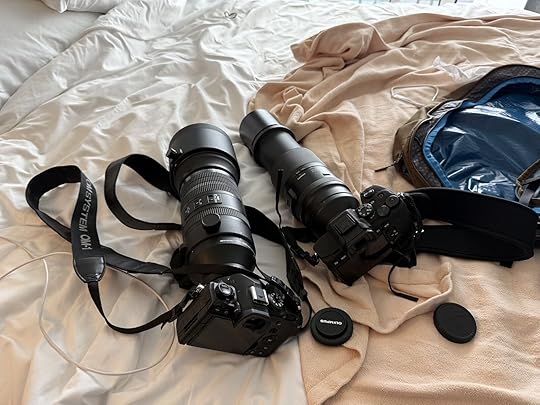
Photo: Suzie Dundas
This is one item on your Arctic packing list where a cheap version won’t do. One of the main reasons to go to the Arctic is to see wildlife, but regulations prevent cruises and boats from getting very close. So you’ll want to have a long lens and a camera that shoots in RAW, not just JPG. I brought my beloved Sony A7IV, with a 150-500 mm lens. But you should do your research before buying (or renting) a nice travel camera, as they are pricey buys.
However, twist: depending on how you visit the Arctic, you may be able to borrow one — for free, no less. I cruised with Lindblad Expeditions, which had on board the Resolution a camera library with cameras, lenses, and accessories you could borrow at absolutely no cost. They’re first-come, first-served, but during my trip, no one else borrowed anything, so I had my choice of cameras every day. It’s worth asking if your tour operator has a similar service, especially if you’re worried about weight issues on small planes to or from places like Svalbard or Tromsø.
A Packable Rain Jacket
Photo: Suzie Dundas
I didn’t end up needing it in Svalbard, both because it didn’t rain much, and because Lindblad Expeditions gives guests on their Arctic cruises a waterproof parka to keep. But in Oslo, it was extremely helpful to have a lightweight rain jacket. Light rain is common there, even in summer, and having a jacket I could toss in my purse and throw on without adding much bulk was key. I’ve been using the Mountain Hardwear Premonition Jacket for nearly a year and have nothing bad to say about it. If you’re looking for an ultralight and ultra-waterproof jacket, it’s one of the best out there, even taking into account the price tag.
Buy Now: $300A Large Carry-on Bag

Photo: Suzie Dundas
It was an 11-hour flight to Oslo from Vancouver for me, then another three hours to Svalbard, so I had to carry a lot with me: a travel pillow and blanket for the plane, an extra layer, snacks, my laptop, chargers, and toiletries, plus all my camera gear. That’s why I used the biggest carry-on I have: The Gregory Border 40. It’s fairly affordable at around $140-$160, and maxes out your carry-on by offering 40 liters of space. It’s spread between two primary compartments (one of which is odor- and moisture-proof), and a few small compartments like a laptop pocket and front zippered pocket. I’ve never had a flight attendant question it as a carry-on, and the soft-sided design means you can easily shove it under an airplane seat — or at least make it look like it’s under the seat well enough for takeoff.
Buy Now: $135More Socks (Always)
Photo: AlexMaster/Shutterstock
I wish I had added more socks to my Arctic packing list. I wore each pair at least twice, and by the end of the trip, I was smell testing them to see which ones were the least offensive. My Lindblad Expeditions trip had six days of on-land excursions, so I would recommend bringing at least that many pairs of tall, thick socks, especially if you’re wearing rental boots. My favorites on my trip were my thickly insulated Smartwool Over-The-Calf socks and my Icebreaker Merino Wool Over-the-Calf socks, both of which were warm when wet and dried quite quickly. Make sure to wear a quick-drying fabric like Merino wool or a synthetic material, as you will probably get snow in your boots if you do any hiking on land, even in summer.
Slip-on Shoes
Photo: Suzie Dundas
I’m obsessed with slip-on insulated slippers — the kind designed for camping and backpacking. I’ve worn pairs from Teva, The North Face, Oboz, Rab, and more, and honestly, they’re all good choices. The ones I wore on board were my unisex Teva ReEmbers, one of the original insulated slippers. I strongly recommend a warm shoe you can easily take on and off to wear on board when walking around and relaxing on the ship. A slipper or other shoe you can slide on in seconds is also useful in case you’re lying in bed when you get word of a polar bear sighting just off the edge of the boat. You don’t want to miss a shot because you’re lacing up your stiff trail shoes.
Buy Now: $48+Things I Didn’t Need to Bring

I borrowed thick, waterproof boots from Lindblad Expeditions, which was way better than buying and carrying a big, bulky pair in my suitcase.
A lot of packing lists for Arctic travel include laundry lists of bulky, hard-to-pack items, so here are a few areas where you can save space. Here’s what I either left at home, or wish I had.
Sunscreen: I brought a huge tube of sunscreen and didn’t need it, mostly because my skin was covered whenever I was outside. Bring an ocean-safe sunscreen for your face and hands, but you probably won’t have much skin exposed to the elements while you’re outside.Boots: Many of the shore landings are in water, which means you’ll need rubber, waterproof boots that come up to your knees. Even if I’d had a pair, which I didn’t, I wouldn’t want to bring them since they take up so much space in a suitcase. Lindblad Expeditions has a boot rental program on board, so I just borrowed a pair from the ship. Many tour companies and gear outfitters offer a similar service, so check if it’s available before you waste time and money on hard-to-pack (and expensive) boots.Waterproof pants: I brought fully waterproof pants, but I’m not sure why. You definitely want a pair of water-resistant hiking pants, or something like a ski pant, but you don’t need the fully waterproof, fisherman-style pants I brought.Extra gloves and beanies: I mostly wore a baseball cap (because Arctic sun) with jacket hood over it. I think I only wore a beanie one time. You should still bring one in case it’s extra-cold, but I’d recommend just a basic, packable knit one, like the tried-and-true beanies from Buff. One pair of gloves would have also sufficed. I wore my medium thickness waterproof gloves most of the time, and didn’t wear the thick ski gloves I brought at all.A GoPro: Everything in the arctic is vast, deep, and landscape-focused — not exactly the kind of shots action cams lend themselves to. Most wildlife you see will be so far away you couldn’t even see them in your footage. If you’re doing a land-based activity like snowmobiling, maybe it makes sense. But for a cruise-based trip, don’t bother. Binoculars: I brought my Nocs Standard Issue binoculars, which are pretty nice, especially for the price — but I didn’t need them. Onboard the Resolution were at least a dozen pairs of binoculars in common spaces anyone could borrow, as well as high-powered spotting scopes that could see much farther than even the best binoculars. You should check if your boat or tour operator has binocs on board, and if so, just use them. However, if you do need your own pair, the Nocs Standard Issue are a smart buy. More like thisOutdoorA Guide to Extreme Adventure in the Alaska Arctic Circle, From Someone Who Did It
More like thisOutdoorA Guide to Extreme Adventure in the Alaska Arctic Circle, From Someone Who Did It
You Can Now Book Travel Deals On Amazon Prime Day, and These Are the Top Offers

You’ve long been able to buy travel gear on Amazon, with particularly great deals on said travel gear over Prime Day. But the site has stepped up its travel game for 2025 Amazon Prime Day, running July 8 through July 11. This year, you can even book actual trips through Amazon, heading everywhere from the shores of northern Michigan to the deck of a Carnival Cruise. You can even rent a car via Avis, straight through your Prime account. Here are the best deals to snag.
Just so you know, Matador may collect a small commission from the links on this page if you decide to book a stay.
Visit Mackinac Island, Traverse City, and Detroit for 15 percent off
Photo: Matthew G Eddy /Shutterstock
Expedia is offering a compelling travel deal for those looking to explore Michigan this summer. Travelers can save up to 15 percent on select hotels and vacation rentals across the state, including popular destinations like Mackinac Island, Traverse City, and Detroit. To take advantage of this offer, bookings must be made by July 21, 2025, for stays through October 31, 2025. Additional discounts are available for One Key members, Expedia’s free loyalty program, which provides exclusive member prices and rewards. This promotion presents an excellent opportunity to experience Michigan’s diverse attractions—from serene lakeshores to vibrant urban centers—while enjoying significant savings on accommodations.
Rent a car through Avis and get an Amazon gift card
Photo: mpohodzhay /Shutterstock
Amazon is offering a compelling travel deal in partnership with Avis, providing Prime members with up to 30% off car rentals when booked through Amazon. This exclusive offer allows travelers to reserve vehicles directly via Amazon’s platform, streamlining the booking process and integrating it with their existing Amazon accounts. The promotion is available for a limited time, making it an opportune moment for those planning summer road trips or upcoming vacations to secure reliable transportation at a discounted rate. By leveraging this deal, travelers can enjoy significant savings on car rentals, enhancing their travel experience while keeping costs in check. You’ll even get 10 percent of the purchase price back as an Amazon gift card – in case you need a piece of gear to bring with you in the rental.
Sail with Carnival for $80 per person, per day
Photo: Mulevich /Shutterstock
This limited-time deal features over 500 itineraries to destinations such as the Bahamas, Mexico, Alaska, and Europe, with trips ranging from quick 3-day getaways to extended 9-day adventures. In addition to substantial fare discounts, travelers can enjoy perks like up to $50 in onboard credit, free room upgrades, and reduced deposits. The Early Saver program also includes price protection, meaning you get the best available rate if prices drop before departure. Whether you’re a seasoned cruiser or planning your first voyage, this promotion presents an excellent opportunity to set sail at a significant savings.
Travel across the US with Amtrak for super cheap
Photo: Audley C Bullock /Shutterstock
Amazon’s Prime Day travel deals also connect you with Amtrak’s Everyday Discounts program. Here you’ll find deals on Amtrak lines across the U.S. Children aged 2–12 ride at 50% off, while infants under 2 travel free with a paying adult. Seniors aged 65 and over receive a 10% discount on most fares. Active-duty military personnel, their spouses, and dependents, as well as military veterans, are eligible for a 10 percent discount. Passengers with disabilities and one traveling companion can also save 10 percent on fares. If you happen to be a member of the Rail Passengers Association, you can take a further 10 percent off whatever you book through the Everyday Deals page, making this the best deal on the rails this summer.
Take 10 percent of hotels in San Diego or Myrtle Beach
Photo: NorthSky Films /Shutterstock
Travelers seeking summer getaways can take advantage of enticing deals in both San Diego and Myrtle Beach. Expedia’s San Diego promotion offers over 10% off select hotels, including upscale options like the Fairmont Grand Del Mar and beachfront favorites such as La Jolla Shores Hotel. These discounts are part of a limited-time offer, providing an excellent opportunity to explore San Diego’s renowned beaches, cultural attractions, and vibrant neighborhoods .
Meanwhile, Myrtle Beach is featuring special rates on a variety of accommodations, from oceanfront resorts to family-friendly hotels. With 60 miles of coastline, entertainment venues, and dining options, Myrtle Beach presents a compelling destination for travelers looking to combine relaxation with activities. 
A New Winter Flight Connects the Midwest to Colorado’s Top Ski Resorts

It’s easy to get to Colorado’s ski resorts from major hubs like Chicago or Dallas, but thanks to a new expansion from Delta Air Lines, skiers from smaller towns can get to the slopes in a weekend, too.
Delta Air Lines just posted new routes on a national flight database, and it looks like residents of the City of Lakes are in luck. Over the Christmas season, from December 20, 2025 to January 5, 2026, the airline will offer daily flights between Minneapolis–Saint Paul International Airport and Eagle County Regional Airport in Gypsum, Colorado. The Eagle County Airport is a short drive from major ski resorts, including Beaver Creek (25 miles), Vail (30 miles), and Copper Mountain (42 miles). Breckenridge is slightly further, at about one hour by car. According to early reporting, the flight will then switch to a once-a-week schedule on Saturdays, running through the end of March 2026.
Also posted was a new daily winter route between Austin-Bergstrom International Airport in Austin, Texas, to Mexico’s Los Cabos International Airport, as well as a daily route between New York City’s JFK Airport and Sarasota, Florida. With the news of the JFK flight came a few cuts: Delta will no longer be flying between JFK and Memphis, Tennessee, or St. Louis, Missouri, in winter.

The new flight delivers skiers to Eagle County Regional Airport in Colorado. Photo: starlyw/Shutterstock
While skiers in the Midwest will likely be thrilled to have a new option, it’s not the only recent expansion from Delta. On June 24, Delta announced two new international flights from its hub in Seattle, Washington. Now, Seattleites can fly direct to Barcelona, Spain, or Rome, Italy. The new flights will launch in May 2026, running three times per week to Barcelona and four times per week to Rome.
Delta also recently launched its first flight from Salt Lake City to Seoul-Incheon (ICN) in Seoul, South Korea. It’s the first direct flight from any destination in Utah to South Korea and operates year-round on a daily basis.
Finally, non-skiers also have some new options on the ever-expanding airline. In April 2025, Delta Air Lines announced two new flights from Atlanta, Georgia, connecting the city with the Caribbean destinations of St. Vincent and the Grenadines (SVD) and Grenada (GND). They’re the first direct flights from Atlanta to these destinations, with both operating daily between December 2025 and April 2026. In May 2026, each route will transition to a once-a-week schedule on Saturdays, before returning to daily service for winter 2026. 
Beyond the Turnpike: Your Guide to New Jersey’s Many Natural Wonders

Those who’ve never visited New Jersey beyond a taxi ride between Newark Airport and New York City may forget that the Garden State is a place of agriculture and natural wonders. And no, experiencing nature in New Jersey isn’t restricted to going down the seaside for sand and surf (although the Jersey Shore holds beloved memories for all who visit, locals and out-of-towners alike).
Jersey is home to dozens of lakes, rivers, waterfalls, giant woodland areas, marshes, and mountains — it’s even graced with a section of the Appalachian Trail (AT). So grab your Jersey State Parks Passport, hop on the NJ Turnpike or Garden State Parkway, find your exit, and explore the many natural wonders the state has to offer.
WATERFALLS CLOSER THAN YOU THINK
Photo: Jon Bilous/Shutterstock
Buttermilk FallsIn Sussex County, in the wilderness of New Jersey’s northwest, lies a waterfall with a frothy white appearance as it cascades down a tiered rockface: the aptly named Buttermilk Falls. At over 75 feet tall, it’s the tallest waterfall in the state, surrounded by green moss and foliage — except in autumn when crimson and auburn hues take over.
You can view the base of the falls from a parking-lot-accessible platform that creates a perfect perch for looking up and marveling at Buttermilk’s height. Want to get even closer? Get your steps in on the stairs leading up to the top of the falls and be rewarded with unreal vistas of the valley below.
Paterson Great FallsIn New Jersey, you don’t need to venture far out of an urban center for scenic cascades. Right in the middle of the historically industrial city of Paterson, co-founded by Alexander Hamilton in 1791, lies the Paterson Great Falls — so great they’re maintained by the National Park Service.
As the biggest set of waterfalls on the Passaic River, they once served as a hydraulic power source for mills and manufacturing. Today, they’re still roaring as the centerpiece of the eponymous national historical park that’s a true natural oasis within urban terrain.
MILE-WIDE VIEWS
Photo: Rabbitti/Shutterstock
Appalachian Trail in High Point State ParkThe storied AT spans from Georgia to Maine and, in doing so, cuts across New Jersey for 72.4 miles. While comparatively speaking this doesn’t seem like much, it’s still quite a feat to hike it all — the segment is the second longest trail in the state — and those doing so will be treated to the elevated views of northwestern New Jersey’s Skylands Region.
The AT passes through High Point State Park, so called for having the state’s highest elevation: 1,803 feet. When you look down at the greenery around you from Monument Tower, you’ll know you’re at the very top of the Garden State.
The Giant Stairs in Palisades Interstate ParkIn Bergen County, just across the Hudson River from northern New York City, lies a park that holds the dramatic natural cliffs known as the Palisades. This impressive landscape evaded riverside real estate development thanks to the Rockefellers. The 700 acres around the precipice were purchased by the oil-rich American family to preserve their natural beauty (specifically, the views from the Rockefeller family mansion).
Ultimately, the land was donated to an interstate New York/New Jersey parks commission, which has maintained its natural wonders and small waterfalls and also created a network of hiking trails. These include the Giant Stairs, a challenging but achievable rock scramble at the base of the Palisades. It’s worth the hike for the views of the river as it expands out to the Hudson Valley.
ADVENTURES ON, IN, AND BY THE WATER
Photo: Photos for the Future/Shutterstock
Lake HopatcongWith 45 miles of shoreline, Lake Hopatcong has been a getaway destination luring city folk since the heyday of railway travel in the 19th century. Today, New Jersey’s largest freshwater lake continues to entice roadtrippers and daytrippers to the state park that bears its name.
There are plenty of ways to enjoy its 2,500 acres (four square miles) of freshwater, be it sailing, kayaking, jet skiing, waterskiing, or paddleboarding. There’s also great fishing, with the waters full of trout, perch, catfish, and freshwater bass. If floating on the water isn’t your thing, go for a hike on one of the many trails around the lake — an activity that’s made more rewarding with a post-trek dip on a hot summer day.
Delaware Water GapNamed for the Delaware River, the Delaware Water Gap National Recreation Area spans most of the northwestern natural boundary between New Jersey and Pennsylvania. Run by the National Park Service, it provides many opportunities for weekend warrior adventures along the water: fishing, canoeing, kayaking, swimming, sunbathing on the shore, camping, or hiking one of its many trails.
The views from the Mount Tammany Red Dot Trail yield spectacular details of this grand geological gap, carved by prehistoric water running through the Kittatinny Range of the Appalachian Mountains. The other big to-do here is inner tubing down the river in summer, an activity facilitated by private operators like Big Bear Gear near Frenchtown.
MORE THAN MEADOWLANDS
Photo: Breck P. Kent/Shutterstock
New Jersey Pinelands National ReserveKnown colloquially as the Pine Barrens, the New Jersey Pinelands is the country’s first national reserve. Established in 1978, it comprises over one million acres of woodlands and wetlands. That’s 22 percent of New Jersey’s landmass, taking up much of the state’s southeast interior.
Some suburban towns exist within its domain, but the Pine Barrens are mostly known for rivers and cedar swamps to paddle and woodsy trails to hike — plus bogs, forests, and farmland where you can explore this diverse biosphere of New Jersey and its flora and fauna (including the elusive Jersey Devil, if you believe you can spot the urban legend). While the Pinelands are managed by the National Park Service, you can sign up for kayaking, hiking, or nature tours with local outfitters like Pinelands Adventures.
The Columbia Trail and Ken Lockwood GorgeIn the central New Jersey county of Hunterdon lies a lesser known but undoubtedly beautiful slice of nature, perfect for hiking or gravel biking. Starting in the quaint town of High Bridge, hikers and bikers journey along the Columbia Trail — a rail trail where trains once traveled — as it cuts through scenic woods and grass fields, paralleling the Raritan River on its way to Chester in Morris County.
However, the most scenic part of the trail comes when it passes Ken Lockwood Gorge, a scenic, woodsy section of the South Branch Raritan River where boulders of all sizes dot the riverbed, standing stoically amid the relaxing sounds of trickling water. The area is a must for nature enthusiasts, especially those who enjoy fly fishing — you’ll see many doing so, holding their rods and standing waist deep in the river.
BEYOND THE BOARDWALK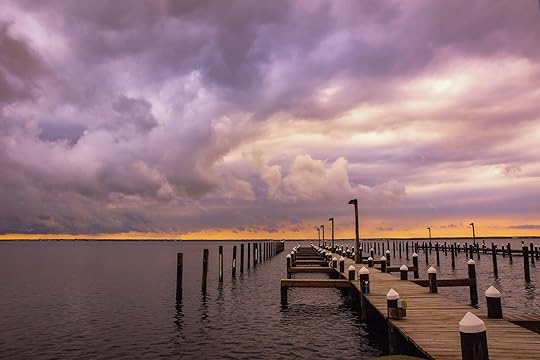
Photo: Scott Heaney/Shutterstock
Cape May Point State ParkYou’d be remiss to visit New Jersey and not go down the shore as the locals do. The stereotypical beach day conjures images of boardwalks, amusement rides, cotton candy, and other human-made attractions. However, there are also sections of the New Jersey coast that serve as nature reserves, including parts of the state’s southernmost tip, the Cape May Peninsula. While the city of Cape May is unique on its own, preserving historical Victorian architecture, the rest of the cape is another departure from the expected Jersey Shore.
Cape May Point State Park is where you’ll find an iconic lighthouse and a reserve for easy nature walks, fishing off the shore, and birdwatching. Spring and fall are when many migratory birds, particularly hawks, find their way here for a pit stop before or after flying over Delaware Bay. It’s also a common stop for migratory monarch butterflies, and horseshoe crabs come ashore to lay their eggs in the sand.
Island Beach State ParkAnother pristine stretch of Jersey shoreline is Island Beach State Park, which spans 10 miles of undeveloped beach habitat on the southern end of a narrow barrier island between Barnegat Bay and the Atlantic Ocean. This protected, undeveloped environment is one of the last remaining barrier beaches on the North Atlantic seaboard, and it harbors over 3,000 acres of coastal dunes and more than 400 plant species. It’s become the sanctuary of New Jersey’s largest osprey colony, along with peregrine falcons and other waterfowl. Since it’s a barrier island that shields the mainland from ocean swells, the adjacent bay is an ideal place for windsurfing, kayaking, fishing, and crabbing.
For the fourth-smallest state in the US, New Jersey is jam-packed with an impressive number of scenic spots to stretch your legs, soak up views, and appreciate the Garden State in its truest sense. Next time you’re in New Jersey, don’t just drive through — dive in. 
July 1, 2025
Teenager Illegally Flies Plane to Antarctica, Gets Detained by Chilean Authorities

Ethan Guo, a 19-year-old American pilot and social media influencer, was detained by Chilean authorities after landing his Cessna 182 aircraft without authorization at the Teniente Marsh aerodrome on King George Island in Antarctica. Guo, who is on a solo mission to fly across all seven continents to raise $1 million for St. Jude Children’s Research Hospital, modified his flight plan without notifying air traffic control, prompting emergency protocols and a search operation by the Chilean Air Force. It was an illegal activity — but for one heck of a cause.
@aaronrheins Teenage Social Media Star Illegally Flies to Antarctica #news #aviation #antarctica #cessna #pilot ♬ original sound – Aaron Rheins
Guo’s journey, which began on May 31, 2024, in Memphis, Tennessee, aims to raise awareness and funds for pediatric cancer research, inspired by his cousin’s battle with the disease. He has documented his travels to over 60 countries on social media, amassing more than 1.2 million followers.
ethansflightagainstcancer.com
The unauthorized detour to Antarctica violated Chile’s Aeronautical Code and the Antarctic Statute, leading the Directorate General of Civil Aviation (DGAC) to file a formal complaint with the Public Ministry. Guo remains in custody pending legal proceedings. You can donate to support Ethan’s childhood cancer fundraising campaign via St. Jude. 
The Real Story Behind the ‘Poop Cruise,’ and Why It (Probably) Won’t Happen Again

In February 2013, a routine Carnival cruise in the Gulf of Mexico turned into an ordeal that would haunt the industry for years. The Carnival Triumph, carrying more 4,000 guests and crew, suffered an engine room fire that knocked out its power and, more importantly, the plumbing. Fast forward 12 years, and it’s the subject of the new Netflix documentary entitled “Trainwreck: Poop Cruise.” Humorous as it is at the surface, the cruise became a defining moment for cruise ship safety and passenger rights. Here’s the real story behind the world’s most infamous recent cruise.
What really happened on the ‘poop cruise?’View this post on InstagramA post shared by crimetimeteatime (@crimetimeteatime)
The trouble began when a fuel leak triggered a fire early in the morning on February 10, 2013. It was quickly extinguished, but destroyed the ship’s main electrical systems and left the Triumph without air conditioning, refrigeration, or functioning toilets. Passengers were forced to improvise, using showers as urinals and defecating into red “biological hazard” bags distributed by the crew. However, the measures proved inadequate over the course of the following five days, with the hazardous waste bins overflowing and sewage seeping into hallways, making many interior spaces uninhabitable. To escape the odor (and the heat), people moved their bedding onto the decks and created makeshift outdoor camps. In a matter of days, fighting broke out, especially as passengers competed for space and limited food, as the crew had to dispose of anything that required refrigeration.
Efforts to tow the ship back to port were stymied by multiple factors. The ship had been sailing from Cozumel, but strong currents meant returning there wasn’t an option. Instead, it was pulled by tugboats to Mobile, Alabama, adding days to the journey. The crew faced the same issues as passengers but continued to work through the conditions. Afterward, many guests complimented their resilience through the disaster.
No one died as a result of the “poop cruise” incident, nor were there serious injuries reported among passengers or crew. However, several passengers did suffer from nausea and vomiting, likely due to the unsanitary conditions, extreme heat, and spoiled food.
How did Carnival respond?
The Carnival Triumph eventually was rebranded as the Carnival Sunrise, shown here. Photo: Carnival News
Initially, Carnival’s public relations team downplayed the incident, calling it an “inconvenience and discomfort.” However, once passengers managed to get online by using Wi-Fi from a nearby ship and shared their experiences on social media, the story quickly gained national attention. Carnival eventually offered full refunds, travel expense reimbursements, $500 in compensation, and a free future cruise, though the damage to its reputation and the cruise industry overall was already done.
The fallout led to significant changes across the cruise industry, most notably the “Cruise Passenger Bill of Rights,” introduced later that year by the Cruise Lines International Association (CLIA). It set new minimum standards for passenger treatment, including mandating emergency power sources, timely updates for passengers, medical care, and the ability to leave the ship if basic needs are not met.
Carnival also invested in safety upgrades, spending $500 million on fire prevention systems and backup generators. The Triumph was also overhauled and rebranded years later as the Carnival Sunrise, which still sails today.
What’s to stop it from happening again?
Photo: TaraPatta/Shutterstock
There have been some federal laws enacted to protect cruise ship passengers, but most of the changes following the “poop cruise” incident were initiated and implemented by the cruise industry itself. The cruise industry has sunk millions into improving its safety and experiential reputation, so it’s likely most companies will do everything they possibly can to avoid another disaster like this one.
Not to be confused with the Cruise Passenger Bill of Rights, introduced and implemented by the industry, members of Congress have repeatedly introduced the Cruise Passenger Protection Act (CPPA), which would expand passenger rights, improve medical standards, and strengthen enforcement and reporting requirements. The most recent introduction was in August 2024. However, as of July 2025, it hasn’t passed. Unfortunately, given the current leanings in Congress away from consumer protections, it’s unlikely to pass in the next few years. 
Airbnb to Host Curated Fan Experiences at Lollapalooza Chicago

Airbnb is elevating the Lollapalooza experience this summer with a lineup of curated fan experiences designed to give festival-goers behind-the-scenes access to the people and culture that power one of Chicago’s biggest events. In partnership with Lollapalooza and as part of Airbnb’s broader entry into the live music space, the company is offering immersive sessions led by creatives, industry insiders, and artists across the four-day festival, running July 31 through August 3, 2025.
Just so you know, Matador may collect a small commission from the links on this page if you decide to make a purchase.
What to know about the Airbnb fan experiences at Lollapalooza
Guests can book a makeup session with celebrity makeup artist Jill Powell. Photo: Airbnb
The Airbnb fan experiences span a range of disciplines—from music production to fashion styling to makeup artistry—and are hosted inside the Airbnb Haven, a VIP-style lounge within the festival grounds. One standout opportunity is a guided backstage tour with festival director Tim Sweetwood, who will walk small groups through typically restricted areas such as artist compounds and production zones, offering a rare look at the logistics and planning behind Lollapalooza’s large-scale production.
Other sessions are designed to highlight the creative spirit of the festival itself. Celebrity stylist Ann-Marie Hoang, known for her work with Rihanna and Beyoncé, is hosting a fashion curation and styling session where attendees can browse statement accessories and festival looks, then receive personalized advice on crafting bold outfits. In a separate workshop, photographer Paul Octavious and a local drag performer will lead a festival street-style photo session, guiding guests in capturing expressive looks and vibrant characters using either smartphones or professional cameras.
Beauty enthusiasts can take part in a makeup masterclass with Jill Powell, a celebrity makeup artist whose clients include Demi Lovato. The hands-on session focuses on practical techniques for creating long-wear, photo-ready festival looks in the often unpredictable Chicago summer heat. Meanwhile, those interested in music production can join a 60-minute session with Chicago’s own DJ Lady D. The workshop covers foundational DJ techniques and the cultural history of house music, blending vinyl skills with digital mixing tools.
All who book an Airbnb-curated experience can access the ‘Airbnb Haven’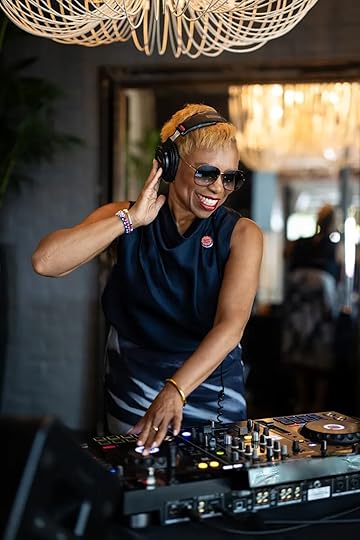
Guests can learn the art of mixing with DJ Lady D. Photo: Airbnb
All Airbnb experience participants receive access to the Airbnb Haven, which includes a shaded lounge, a cash bar, upgraded restroom facilities, and quiet corners to recharge. While a general admission or VIP Lollapalooza ticket is still required for entry to the festival, the Haven adds an exclusive layer of access for Airbnb users. Attendees must have an active Airbnb stay or experience booking during the festival to enter.
These experiences are priced individually and are available in limited quantities. Most sessions accommodate small groups to maintain an intimate, hands-on atmosphere. Bookings are available now through Airbnb.
As part of Airbnb’s first global music partnership, the Lollapalooza fan experiences reflect a growing trend of lifestyle integration at major festivals. By combining accommodation with curated cultural programming, Airbnb aims to position itself not just as a lodging platform but as a gateway to deeper engagement with live events. 
The Best Airbnbs Near Atlanta’s Mercedes-Benz Stadium for Soccer Fans

Atlanta’s Mercedes-Benz Stadium is set to draw soccer fans from around the world, with the FIFA World Cup taking over the city next summer. That also means local Airbnbs are going to book up faster than you can order a plate of lemon pepper wings. Unlike hotels, snagging a vacation rental offers you the freedom to cook (when you want to) plus outdoor spaces like rooftops and living rooms where you can kick back and watch replays in peace. They’re also a great way to have a more authentic experience in Atlanta — whether that’s unwinding on your own skyline deck, grilling out in a backyard, or walking home through the lively neighborhood streets after the match. From colorful studios near breweries to massive townhomes, all but one listing here is within walking distance, so rest assured these are going to be some of the most sought-after Airbnbs near Mercedes-Benz Stadium.
We hope you love the Airbnbs near Mercedes-Benz Stadium we recommend! Just so you know, Matador may collect a small commission from the links on this page if you decide to book a stay. Listed prices are accurate as of the time of publication.
Traveling to Atlanta for the World Cup? Check out Matador’s World Cup guides: The 9 Best Soccer Bars in Atlanta for Watching the World Cup Where to Eat, Play, and Stay During the Atlanta World Cup Games The Best Hotels Near Atlanta’s Mercedes-Benz Stadium for Soccer Fans The Coolest Atlanta Hotels in the Heart of the City The Best Breweries and Places to Grab a Beer in Atlanta Multi-level Castleberry Hill townhouse with skyline rooftop Photo: Airbnb
Photo: Airbnb Photo: Airbnb
Photo: Airbnb Photo: Airbnb
Photo: Airbnb Photo: AirbnbSee more photos
Photo: AirbnbSee more photosDistance from Mercedes-Benz Stadium: 10-minute walk
If you’re rolling into Atlanta with your crew to catch a World Cup match, this three-bedroom townhouse in Castleberry Hill puts you within a 10-minute walk of Mercedes-Benz Stadium — close enough that you can stroll to the game without worrying about parking. Across its multiple stylishly decorated levels, you’ll find a private rooftop deck with a fireplace and TV, plus skyline views across downtown. Each bedroom comes with its own bathroom, so everyone has a little privacy. The kitchen is stocked with all the cookware you might need if you’d rather have dinner in, though Peters Street’s restaurants and street art are a block away if you want to explore. It’s worth noting there are train tracks nearby, so light sleepers might want earplugs. But if you’re here to watch world-class soccer and enjoy Atlanta’s nightlife, the location and spacious layout make it a fantastic home base for a group trip.
Six guests, three bedrooms
Price: $225 per night
 Photo: Airbnb
Photo: Airbnb Photo: Airbnb
Photo: Airbnb Photo: Airbnb
Photo: Airbnb Photos: AirbnbSee more photos
Photos: AirbnbSee more photosDistance from Mercedes-Benz Stadium: 10-minute walk
This roomy one-bedroom loft in Castleberry Hill is set in a converted elevator factory, and you’ll see that history in the exposed brick, reclaimed wood floors, and custom tile work. The kitchen has pro-level appliances and a big island if you feel like cooking, though, again, plenty of restaurants are right around the corner. There’s a private parking spot in the garage and smart entry so you can check in without any hassle. Past guest reviews mention the place was bigger than expected, with a shower that feels like something out of a design magazine, and most note that the location and style make it a standout spot for catching a game and exploring downtown Atlanta.
Three guests, one bedroom
Price: $307 per night
 Photo: Airbnb
Photo: Airbnb Photo: Airbnb
Photo: Airbnb Photo: Airbnb
Photo: Airbnb Photo: AirbnbSee more photos
Photo: AirbnbSee more photosDistance from Mercedes-Benz Stadium: 10-minute walk
This Castleberry Hill loft shares a building with the one-bedroom option above but is more suited for two couples or a larger family, thanks to a main bedroom with an en-suite bath and a second semi-private sleeping area with its own half bath. Exposed brick, reclaimed wood floors, and custom finishes give it plenty of character, and there’s a rooftop lounge for a bit of fresh air before you head out to the match. If you’d rather skip the restaurants nearby, the host can organize a private chef for dinner after the game.
Six guests, two bedrooms
Price: $307 per night
 Photos: Airbnb
Photos: Airbnb Photos: Airbnb
Photos: Airbnb Photos: AirbnbSee more photos
Photos: AirbnbSee more photosDistance from Mercedes-Benz Stadium: 10-minute walk
I’m getting serious Miami vibes from this colorful studio with its teal walls, tropical prints, and a pool deck that wouldn’t look out of place in South Beach. This Airbnb puts you in the Margaritaville Vacation Club, surrounded by some of Atlanta’s best spots for a drink. Wild Leap Atlanta — a brewery, distillery, and winery with a huge taproom and outdoor patio — is right next door, and Fellaship, Cam Newton’s sleek lounge for cocktails and live jazz, is just steps away. The studio sleeps four with a king bed and a queen sleeper sofa, and while the kitchen is more of a snack station, past reviews say the place is spotless and the hosts go out of their way to help. Just note that valet parking is available for $55 per night.
Four guests, studio
Price: $144 per night
 Photo: Airbnb
Photo: Airbnb Photo: Airbnb
Photo: Airbnb Photo: Airbnb
Photo: Airbnb Photo: AirbnbSee more photos
Photo: AirbnbSee more photosDistance from Mercedes-Benz Stadium: 10-minute walk
If you’d rather have a house, this three-bedroom Airbnb in Vine City is about as close as you’ll get without camping in the stadium parking lot. You’ve got a king suite and two queen bedrooms, plus a backyard deck. The kitchen is stocked with cooking basics, and the host gets rave reviews for responsiveness — more than one traveler said they felt treated like family. If you’re traveling with a group, the living room and dining table are ideal for entertaining, and you’re about a 10-minute walk from the stadium entrance, depending on how fast you move after a pre-game beer in the garden.
Six guests, three bedrooms
Price: $224 per night
 Photo: Airbnb
Photo: Airbnb Photo: Airbnb
Photo: Airbnb Photo: Airbnb
Photo: Airbnb Photo: AirbnbSee more photos
Photo: AirbnbSee more photosDistance from Mercedes-Benz Stadium: 25-minute walk
This two-bedroom Airbnb in downtown Atlanta comes with some bragging rights — like a rooftop bowling alley and skyline views from nearly every window. Inside, you’ll find big windows, simple modern decor, and a kitchen with stainless steel appliances for when you’re not sampling the restaurants around Centennial Olympic Park. There’s a king bed and a queen bed, plus a shared pool and gym. Past reviews call out how spotless the place was and how fast the hosts responded to questions. Parking for two cars is included, which is a nice perk in this part of town.
Four guests, two bedrooms
Price: $155 per night
 Photo: Airbnb
Photo: Airbnb Photo: Airbnb
Photo: Airbnb Photo: Airbnb
Photo: Airbnb Photo: AirbnbSee more photos
Photo: AirbnbSee more photosDistance from Mercedes-Benz Stadium: 20-minute walk
This one-bedroom garage apartment near the BeltLine connector has a mid-century look with wood accents and a warm color palette. There’s a king bed and a sofa bed if you’re traveling with a kid or an extra friend, plus a small kitchen with everything you’d need to put together breakfast or a quick dinner. Past guests mention the place was spotless and comfortable, and more than one traveler said it was nicer than a typical hotel stay. It’s about a 20-minute walk to Mercedes-Benz Stadium and close enough to downtown attractions to avoid requesting a rideshare.
Three guests, one bedroom
Price: $300 per night
 Photo: Airbnb
Photo: Airbnb Photo: Airbnb
Photo: Airbnb Photo: Airbnb
Photo: Airbnb Photo: AirbnbSee more photos
Photo: AirbnbSee more photosDistance from Mercedes-Benz Stadium: 15-minute drive
At this Airbnb, you’ll be about a 15-minute drive from Mercedes-Benz Stadium, but in exchange you get a three-bedroom duplex in Old Fourth Ward with more amenities than most hotels downtown. The main suite has a fireplace and a spa-style bathroom with a rain shower under a skylight, plus you’ll have two other bedrooms, each with their own bath. Past reviews helped earn this place a spot in the top 10 percent of Airbnbs, thanks to how spotless and thoughtfully stocked it is. The rooftop is wild. There’s a copper soaking tub, a fire pit, and a full-size bed swing. You’re also close to Krog Street Market, Ponce City Market, and the BeltLine if you want to spend your downtime exploring, and there’s parking for two cars out front.
Six guests, three bedrooms
Price: $272 per night
 Photo: Airbnb
Photo: Airbnb Photo: Airbnb
Photo: Airbnb Photo: Airbnb
Photo: Airbnb Photo: AirbnbSee more photos
Photo: AirbnbSee more photosDistance from Mercedes-Benz Stadium: 10-minute walk
Less than 10 minutes on foot from Mercedes-Benz Stadium, this three-bedroom townhouse gives you a modern base close to the action. A king bed and two queens cover sleeping arrangements, and the open kitchen has what you need if you’d rather eat in. The rooftop deck faces downtown which is a great spot to enjoy some takeout after a match. State Farm Arena, Centennial Olympic Park, and the Georgia Aquarium are all within walking distance if you want to mix in something besides soccer.
Six guests, three bedrooms
Price: $289 per night
 Photo: Airbnb
Photo: Airbnb Photo: Airbnb
Photo: Airbnb Photo: Airbnb
Photo: Airbnb Photo: AirbnbSee more photos
Photo: AirbnbSee more photosDistance from Mercedes-Benz Stadium: 15-minute walk
If you’re traveling with a squad, this three-bedroom townhome sleeps up to ten and puts you about a 15-minute walk from Mercedes-Benz Stadium. You can actually see the field lights from the rooftop deck — which comes with a wet bar, an ice maker, and a big-screen TV. Two of the bedrooms have king beds, and the third has four bunk beds for whoever draws the short straw. Past the front security gate, you’re only a few blocks from State Farm Arena and the World Congress Center if you want to tack on other events. 
10 guests, three bedrooms
Price: $289 per night
The Best Airbnbs Near Houston’s NRG Stadium for Soccer Fans

When the FIFA World Cup arrives in 2026, Houston will be one of several Texas cities welcoming thousands of fans eager to watch the world’s best teams compete. NRG Stadium, home to the NFL’s Texans and countless championship games over the years, is set to host seven matches, including two knockout rounds. The stadium sits about 20 minutes south of downtown, and while hotels cluster around the Texas Medical Center, Airbnbs offer more flexibility, comfort, and local character — especially if you’re planning to stay longer than a few nights.
There are bright one-bedroom apartments just a few blocks from the light rail, townhomes with plenty of room for groups, and family-friendly condos with rooftop patios. While there are a handful of options within walking distance, many of the better multi-bedroom Airbnbs are just minutes from NRG Stadium by car or transit, with easy access to Midtown nightlife and restaurants in Montrose when you need a break from the crowds.
From group-friendly stays with pools and game rooms to smart studios near the action, here are the top Airbnbs in Houston for soccer fans coming to the World Cup.
Airbnbs near NRG Stadium | Large-group Airbnbs | Airbnbs in The Heights | Montrose | The Museum DistrictWe hope you love the Airbnb Houston properties we recommend! Just so you know, Matador may collect a small commission from the links on this page if you decide to book a stay. Listed prices are accurate as of the time of publication.
Traveling to Houston for the World Cup? Check out Matador’s World Cup guides: The Best Hotels Near Houston’s NRG Stadium for Soccer Fans The Best Airbnbs in Houston, Texas, With Pools and Backyard Facilities The 9 Best Bars in Houston to Watch The 2026 FIFA World Cup Where to Eat, Play, and Stay in Houston During the FIFA World Cup The Best Soccer-Themed Airbnbs for a World Cup Watch Party Airbnbs near NRG StadiumBig townhouse near Rice Village Photo: Airbnb
Photo: Airbnb Photo: Airbnb
Photo: Airbnb Photo: Airbnb
Photo: Airbnb Photo: AirbnbSee more photos
Photo: AirbnbSee more photosAbout 10 minutes from NRG Stadium, this three-story townhouse offers four bedrooms across 3,000 square feet, including a king suite featuring a soaking tub and a walk-in closet. The kitchen has a gas range, a blender for match-day margaritas, and plenty of storage space for groceries. Out back, a string-lit patio with wicker chairs is a great place to relax without having to head out to a bar. Parking is generous, with garage and driveway space for six cars. The location keeps you close to Rice Village restaurants and big screens at Little Woodrow’s sports bar and far enough from stadium traffic to avoid the gridlock if you’re not at a fixture.
Eight guests, four bedroom
Price: $338 per night
 Photo: Airbnb
Photo: Airbnb Photo: Airbnb
Photo: Airbnb Photo: Airbnb
Photo: Airbnb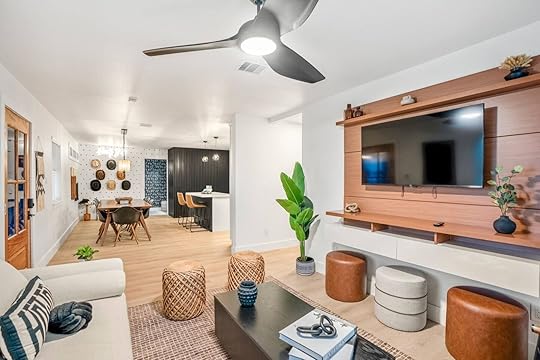 Photo: AirbnbSee more photos
Photo: AirbnbSee more photosHalf an hour on foot from NRG Stadium, this four-bedroom spot has plenty of sleeping space spread over two levels, including a king suite and a bunk room. Out back, there’s a gravel patio with a fire pit, a grill, and oversized games for evening entertainment. You’ll be a short walk from coffee shops and casual restaurants along Main Street, and a quick drive to the Museum District, Hermann Park, and the Houston Zoo if you’re planning to explore more of the city between games. Free parking and keyless entry are a plus and because this is one of the best Airbnbs within walking distance for groups, be sure to book in advance.
10 guests, four bedroom
Price: $280 per night
 Photo: Airbnb
Photo: Airbnb Photo: Airbnb
Photo: Airbnb Photo: Airbnb
Photo: Airbnb Photo: Airbnb
Photo: AirbnbSee more photos
This modern, rustic mid-rise apartment sits less than a mile from NRG Stadium and about 10 minutes from downtown Houston. You can cook in the chef’s kitchen, complete with stainless steel appliances, an island for extra prep space, and a separate dining area. From there, the open floor plan leads into the living room, where large windows fill the space with natural light and the couch pulls out into a sleeper sofa. The primary bedroom has a king-size bed, and the second bedroom a queen. There’s a private patio and you’ll also have access to the complex’s shared amenities, including a business center, pool, and gym.
Five guests, two bedrooms
Price: $115 per night
 Photo: Airbnb
Photo: Airbnb Photo: Airbnb
Photo: Airbnb Photo: AirbnbSee more photos
Photo: AirbnbSee more photosThis bright, affordable one-bedroom apartment sits an easy five-minute walk from NRG Stadium and is ranked among the top 10 percent of listings on Airbnb. It has space for up to four, with a private bedroom and a sleeper sofa in the living area. You’ll have access to two outdoor pools, a gym, and free parking. When you’re ready to explore beyond the stadium, it’s a short drive to the Museum District, Rice University, and plenty of restaurants and bars in Midtown.
Four guests, one bedroom
Price: $79 per night
 Photo: Airbnb
Photo: Airbnb Photo: Airbnb
Photo: Airbnb Photo: Airbnb
Photo: Airbnb Photo: Airbnb
Photo: AirbnbA block from the Medical Center and about a 20-minute walk to NRG Stadium, this two-bedroom apartment offers a chic (and budget-friendly) base for match days and city exploring. Both bedrooms have their own bathrooms and smart TVs with streaming access, and there’s a kitchen with granite counters and a dishwasher for simple meals. The building includes a fitness center, yoga room, a pool, and secure parking in a covered garage. You’ll be close to restaurants along Main Street and a quick drive to the Museum District and Hermann Park. The apartment is ranked among Airbnb’s top five percent of listings, and the layout works well for two couples or a small group.
See more photos
Four guests, two bedrooms
Price: $197 per night
 Photo: Airbnb
Photo: Airbnb Photo: Airbnb
Photo: Airbnb Photo: AirbnbSee more photos
Photo: AirbnbSee more photosSimple, affordable, and modern, this one-bedroom is around a 25-minute walk from the stadium and offers a king-sized bed, blackout curtains, and a roomy living area. The rental includes access to reserved parking in a gated garage, plus access to a gym, pool, and shared lounge areas. Previous guests mention that check-in is quick and the apartment feels exactly as pictured, with many noting the spotless condition and easy communication with the host. You’ll be about 10–15 minutes by car from downtown restaurants and the Galleria, and close to Rice University and Hermann Park if you plan to see more of the city between matches.
Three guests, one bedroom
Price: $141 per night
 Photo: Airbnb
Photo: Airbnb Photo: Airbnb
Photo: Airbnb Photo: Airbnb
Photo: Airbnb Photo: Airbnb
Photo: AirbnbSee more photos
This bright and airy townhome sits in East Downtown, just minutes from some of Houston’s best spots. Large windows fill the space with natural light, and the interior is modern with a few nods to Texas styling. There are three bedrooms — one with a California king-size bed and two with queen-size beds. The spacious bathroom has a soaking tub where you can unwind between outings. In the kitchen, white countertops and stainless steel appliances make it easy to cook your favorite meals. The living room has a comfortable couch, a large-screen TV, and a Bluetooth surround system.
Eight guests, three bedrooms
Price: $114 per night
 Photo: Airbnb
Photo: Airbnb Photo: Airbnb
Photo: Airbnb Photo: Airbnb
Photo: Airbnb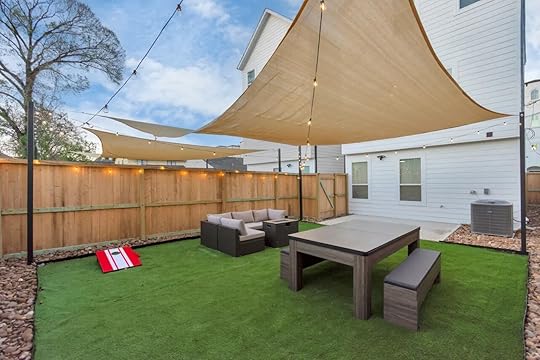 Photo: Airbnb
Photo: AirbnbSee more photos
This East Downtown Houston property has three bedrooms and 3.5 bathrooms, each with a soaking tub. The interior combines natural materials and minimalist design, creating an inviting atmosphere throughout. In the living area, you’ll find an 85-inch smart TV, an electric fireplace, and plenty of space to relax. The primary bedroom includes a king-size bed and a walk-in closet, the second has a queen-size bed, and the third offers two full-size beds, with all bedrooms featuring en-suite bathrooms. The kitchen overlooks the city and is equipped with modern appliances for cooking, and out back, there’s a yard with a gas grill.
Ten guests, three bedrooms
Price: $222 per night
 Photo: Airbnb
Photo: Airbnb Photo: Airbnb
Photo: Airbnb Photo: Airbnb
Photo: Airbnb Photo: Airbnb
Photo: AirbnbSee more photos
This contemporary three-bedroom, two-and-a-half-bathroom house sits in a central spot in East Downtown Houston. The open kitchen pairs warm wood details with crisp white tile and is equipped with modern appliances and a dining area for shared meals. The primary bedroom has a king-size bed, plenty of closet space, and a couch for lounging. Another bedroom includes a queen-size bed, and the third has two double beds. In the living room, you can pick up a book or unwind with a movie on the large TV and sound system. You can also step onto the balcony for fresh air or head to the backyard to gather around the fire pit or fire up the grill.
Eight guests, three bedrooms
Price: $211 per night
 Photo: Airbnb
Photo: Airbnb Photo: Airbnb
Photo: Airbnb Photo: Airbnb
Photo: Airbnb Photo: Airbnb
Photo: AirbnbSee more photos
A modern property in Houston’s Sunnyside neighborhood, this Airbnb combines a neutral color palette with with upscale furnishings. Three bedrooms accommodate up to six travelers, with the master suite featuring a king bed, walk-in closet, and private bathroom. The sectional sofa converts to a sleeper and comes equipped with cup holders and smartphone chargers. Located about 15-20 minutes from NRG Stadium and just 10 minutes from downtown Houston, you’ll have easy access to both the stadium and the city’s restaurant scene.
Eight guests, three bedrooms
Price: $109 per night
 Photo: Airbnb
Photo: Airbnb Photo: Airbnb
Photo: Airbnb Photo: Airbnb
Photo: Airbnb Photo: Airbnb
Photo: AirbnbSee more photos
A recently renovated four-bedroom, three-bathroom house in a quiet Houston neighborhood, this Airbnb puts you within an easy drive of downtown while offering plenty of space for groups or families. A dedicated game room has a pool table and a mix of board games, and the living area includes a 70-inch TV with a soundbar. The kitchen is outfitted with bright white cabinets, modern appliances, and a Keurig, plus a separate dining room with a table for six. The primary bedroom has a king-size bed, while a second room offers two twin bunk beds and one full-size bunk. A third bedroom has a full-size bed, and a fourth includes a queen-size bed. High ceilings and minimalist design keep the space open and comfortable. Out back, there’s a grassy yard with a patio and seating area.
Fourteen guests, four bedrooms
Price: $266 per night
 Photo: Airbnb
Photo: Airbnb Photo: Airbnb
Photo: Airbnb Photo: Airbnb
Photo: Airbnb Photo: Airbnb
Photo: AirbnbSee more photos
A contemporary three-bedroom home in Central Houston, this new build pairs smart technology with bright, comfortable spaces. Each bedroom has a private bathroom and memory foam mattresses. The primary suite features a king-size bed, walk-in closet, an attached bathroom with a soaking tub, and a large window framing downtown views and the two additional bedrooms each have a queen-size bed. In the living area, tan Italian leather couches face a 75-inch TV, and sliding doors open onto a balcony. The kitchen is stocked with essentials and fitted with sleek appliances, while wood floors and eclectic wall art create a warm, bohemian feel throughout the house.
Six guests, three bedrooms
Price: $160 per night
Airbnb Houston rentals in The HeightsPalm Springs-style house that sleeps up to 12 guests
 Photo: Airbnb
Photo: Airbnb Photo: Airbnb
Photo: Airbnb Photo: Airbnb
Photo: Airbnb Photo: AirbnbSee more photos
Photo: AirbnbSee more photosThis three-bedroom Heights home goes all out with Palm Springs colors, from the turquoise pool fence to the striped patio loungers and the speakeasy-style arcade hidden behind the garage door. The main house sleeps six, with two king bedrooms and a queen, while the garage apartment has bunks that can work for extra friends or late arrivals. Out back, you’ll find a heated pool, mini golf, and oversized yard games and indoors you’ll find air hockey, shuffleboard, and classic arcade games. The location is a few blocks from White Oak’s cafes and bars, and about a 15-minute drive to downtown and the stadium.
12 guests, four bedroom
Price: $519 per night
 Photo: Airbnb
Photo: Airbnb Photo: Airbnb
Photo: Airbnb Photo: Airbnb
Photo: Airbnb Photo: Airbnb
Photo: AirbnbSee more photos
This four-bedroom house sits about 10 minutes from downtown Houston and within 20 minutes of most spots in the city. The main house and a detached garage apartment are set up for short or longer stays. Interiors feel bright and heritage-inspired, with tall double-hung windows, tufted seating, and reclaimed wood floors that nod to the neighborhood’s history. Each bedroom has its own character, including a primary suite with a king bed and a bathroom with a soaking tub, and there’s plenty of space for kids or extra guests between the twin bunk beds and queen bed in the additional rooms. You can roll open the doors to the patio and have dinner under a canopy of string lights or fire up the grill if you’d rather stay in. A bike and hike trail sits a block away, and when you’re ready to head farther afield, quick freeway access puts you near the Galleria, the Energy Corridor, and the stadiums.
Four guests, one bedroom
Price: $114 per night
Airbnb Houston rentals in MontroseBohemian bungalow with outdoor patio and swing lounge
 Photo: Airbnb
Photo: Airbnb Photo: Airbnb
Photo: Airbnb Photo: Airbnb
Photo: Airbnb Photo: Airbnb
Photo: AirbnbSee more photos
A two-story house in Montrose, this creative spot feels like an easygoing home base with a touch of character. You’ll have the open living area — filled with bright houseplants, pink Eames dining chairs, and eclectic wall art — and the shaded terrace with hammocks and papasan swings. The kitchen comes stocked with basics if you feel like cooking, and there’s a small art wall where you can leave your own mark. When you’re ready to explore, the Museum District, Midtown, and Downtown are all minutes away by bike or rail. It’s an easy walk to coffee shops, bakeries, and restaurants in every direction, and you can join a neighborhood walking tour to hear stories about Houston’s first downtown-adjacent suburb. A vintage trailer parked in the yard is available to rent if you’re traveling with a larger group, and inside the main house, you’ll find thoughtful extras like books, board games, a clothing steamer, and bathrobes.
Four guests, one bedroom
Price: $135 per night
 Photo: Airbnb
Photo: Airbnb Photo: Airbnb
Photo: Airbnb Photo: Airbnb
Photo: Airbnb Photo: Airbnb
Photo: AirbnbSee more photos
Set on a main street in Montrose, this two-bedroom duplex puts you right between the Galleria and Museum District, with restaurants, cafes, and shops in every direction. You can catch the Metro bus just a minute’s walk from the front door or head out by bike to explore Buffalo Bayou trails and the historic neighborhoods nearby. Downstairs has an open kitchen and living space with playful decor—think bright art, pops of color, and a mix of modern and heritage details — and upstairs you’ll find two bedrooms and a full bathroom. A gated parking area holds two cars, and whether you’re here for a quick work trip or a week of museum hopping, you’ll be within about 20 minutes of most of Houston’s best spots.
Five guests, two bedrooms
Price: $201 per night
Airbnb Houston rentals in The Museum DistrictNewly renovated modern and fashionable apartment
 Photo: Airbnb
Photo: Airbnb Photo: Airbnb
Photo: Airbnb Photo: Airbnb
Photo: Airbnb Photo: Airbnb
Photo: AirbnbSee more photos
Right in the Museum District, this two-bedroom apartment is a practical home base if you’re in town for a match at NRG Stadium or a week exploring Houston’s restaurants and museums. The layout is open and bright, with a kitchen stocked for cooking, an island for extra counter space, and a living area with comfortable seating and a smart TV. Both bedrooms have quality bedding, and there’s dedicated parking for two cars. You can walk to the Museum of Fine Arts, the Natural Science Museum, or Hermann Park in under 15 minutes, and the METRORail stops nearby if you’d rather head to Midtown, Downtown, or NRG without driving. Dogs are welcome, and self check-in makes arrivals simple, whether you’re coming in late or planning an early start.
Six guests, two bedrooms
Price: $152 per night
 Photo: Airbnb
Photo: Airbnb Photo: Airbnb
Photo: Airbnb Photo: Airbnb
Photo: Airbnb Photo: Airbnb
Photo: AirbnbSee more photos
Set between downtown Houston and the Museum District, this family home features original paintings by local artist Rylie Caldwell that brighten the living spaces — which include two lounges, one with a reclining massage chair and access to the patio. The bedrooms are all on one floor, and the kitchen has a coffee bar, plenty of cookware, and a formal dining area for meals in. If you’re in town for a match at NRG Stadium or catching a show in the Theater District, you’ll have an easy time getting around — bike rentals, the light rail, and major highways are all close by. The private driveway fits two cars, and the neighborhood has a mix of restaurants and bakeries within walking distance. 
Six guests, three bedrooms
Price: $291 per night
Matador Network's Blog
- Matador Network's profile
- 6 followers



